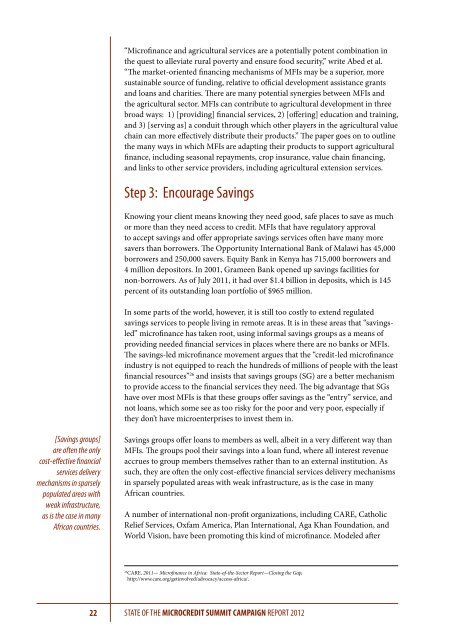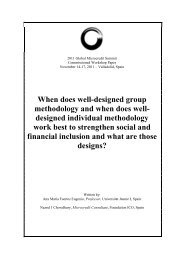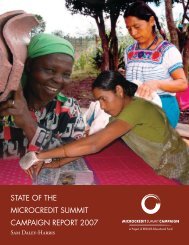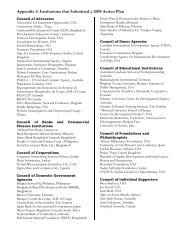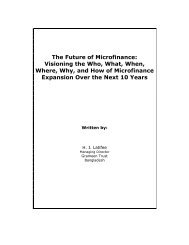Download this Document
Download this Document
Download this Document
Create successful ePaper yourself
Turn your PDF publications into a flip-book with our unique Google optimized e-Paper software.
“Microfinance and agricultural services are a potentially potent combination in<br />
the quest to alleviate rural poverty and ensure food security,” write Abed et al.<br />
“The market-oriented financing mechanisms of MFIs may be a superior, more<br />
sustainable source of funding, relative to official development assistance grants<br />
and loans and charities. There are many potential synergies between MFIs and<br />
the agricultural sector. MFIs can contribute to agricultural development in three<br />
broad ways: 1) [providing] financial services, 2) [offering] education and training,<br />
and 3) [serving as] a conduit through which other players in the agricultural value<br />
chain can more effectively distribute their products.” The paper goes on to outline<br />
the many ways in which MFIs are adapting their products to support agricultural<br />
finance, including seasonal repayments, crop insurance, value chain financing,<br />
and links to other service providers, including agricultural extension services.<br />
Step 3: Encourage Savings<br />
Knowing your client means knowing they need good, safe places to save as much<br />
or more than they need access to credit. MFIs that have regulatory approval<br />
to accept savings and offer appropriate savings services often have many more<br />
savers than borrowers. The Opportunity International Bank of Malawi has 45,000<br />
borrowers and 250,000 savers. Equity Bank in Kenya has 715,000 borrowers and<br />
4 million depositors. In 2001, Grameen Bank opened up savings facilities for<br />
non-borrowers. As of July 2011, it had over $1.4 billion in deposits, which is 145<br />
percent of its outstanding loan portfolio of $965 million.<br />
In some parts of the world, however, it is still too costly to extend regulated<br />
savings services to people living in remote areas. It is in these areas that “savingsled”<br />
microfinance has taken root, using informal savings groups as a means of<br />
providing needed financial services in places where there are no banks or MFIs.<br />
The savings-led microfinance movement argues that the “credit-led microfinance<br />
industry is not equipped to reach the hundreds of millions of people with the least<br />
financial resources” 26 and insists that savings groups (SG) are a better mechanism<br />
to provide access to the financial services they need. The big advantage that SGs<br />
have over most MFIs is that these groups offer savings as the “entry” service, and<br />
not loans, which some see as too risky for the poor and very poor, especially if<br />
they don’t have microenterprises to invest them in.<br />
[Savings groups]<br />
are often the only<br />
cost-effective financial<br />
services delivery<br />
mechanisms in sparsely<br />
populated areas with<br />
weak infrastructure,<br />
as is the case in many<br />
African countries.<br />
Savings groups offer loans to members as well, albeit in a very different way than<br />
MFIs. The groups pool their savings into a loan fund, where all interest revenue<br />
accrues to group members themselves rather than to an external institution. As<br />
such, they are often the only cost-effective financial services delivery mechanisms<br />
in sparsely populated areas with weak infrastructure, as is the case in many<br />
African countries.<br />
A number of international non-profit organizations, including CARE, Catholic<br />
Relief Services, Oxfam America, Plan International, Aga Khan Foundation, and<br />
World Vision, have been promoting <strong>this</strong> kind of microfinance. Modeled after<br />
26<br />
CARE, 2011— Microfinance in Africa: State-of-the-Sector Report—Closing the Gap,<br />
http://www.care.org/getinvolved/advocacy/access-africa/.<br />
22<br />
STATE OF THE MICROCREDIT SUMMIT CAMPAIGN REPORT 2012


